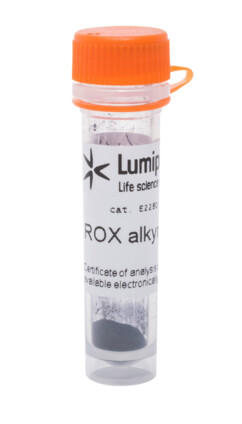FAM DBCO, 6-isomer
| Cat. # | Quantity | Price | Lead time | Buy this product |
|---|---|---|---|---|
| 151F0 | 1 mg |
$110
|
in stock | |
| 251F0 | 5 mg |
$160
|
in stock | |
| 451F0 | 25 mg |
$260
|
in stock | |
| 551F0 | 50 mg |
$370
|
5 days | |
| 651F0 | 100 mg |
$525
|
5 days |

Fluorescein (FAM) is one of the oldest yet well-known fluorescent dyes. This derivative of FAM contains the cyclooctyne group (dibenzocyclooctyne, DBCO or ADIBO). Pure 6-isomer. DBCO reacts quickly and efficiently with azides by simply mixing the components without the need for a copper catalyst (so-called sterically promoted cycloaddition reaction or SPAAC).
FAM DBCO can be used for the labeling of proteins, peptides, nucleic acids, and other molecules containing azide groups. Fluorescein can be detected using a variety of different instruments.
Absorption and emission spectra of FAM

Customers also purchased with this product
General properties
| Appearance: | orange solid |
| Molecular weight: | 676.71 |
| Molecular formula: | C42H32N2O7 |
| Solubility: | good in DMF, DMSO |
| Quality control: | NMR 1H, HPLC-MS (95%) |
| Storage conditions: | Storage: 24 months after receival at -20°C in the dark. Transportation: at room temperature for up to 3 weeks. Avoid prolonged exposure to light. Desiccate. |
| MSDS: | Download |
| Product specifications |
Spectral properties
| Excitation/absorption maximum, nm: | 492 |
| ε, L⋅mol−1⋅cm−1: | 74000 |
| Emission maximum, nm: | 517 |
| Fluorescence quantum yield: | 0.93 |
Product citations
- Kaneda, K.; Takeuchi, Y.; Yamanaka, K.; Hasebe, F.; Maruyama, C.; Hamano, Y. Cell-penetrating activity of a short-chain ε-poly-l-α-lysine. Journal of Bioscience and Bioengineering, 2024, 138(3), 249-253. doi: 10.1016/j.jbiosc.2024.06.006
- Wu, F.; Ren, Y.; Lv, W.; Liu, X.; Wang, X.; Wang, C.; Cao, Z.; Liu, J.; Wei, J.; Pang, Y. Generating dual structurally and functionally skin-mimicking hydrogels by crosslinking cell-membrane compartments. Nature Communications, 2024, 15(1), 802. doi: 10.1038/s41467-024-45006-7
- Jaiswal, M.; Tran, T. T.; Guo, J.; Zhou, M.; Kundu, S.; Guo, Z.; Fanucci, G. E. Spin-Labeling Insights into How Chemical Fixation Impacts Glycan Organization on Cells. Appl Magn Reson, 2023. doi: 10.1007/s00723-023-01624-w
- Sapozhnikova, K. A.; Gulyak, E. L.; Misyurin, V. A.; Simonova, M. A.; Ryabukhina, E. V.; Alexeeva, A. V.; Tikhonova, N. A.; Lyzhko, N. A.; Popova, G. P.; Misyurin, A. V.; Ustinov, A. V.; Korshun, V. A.; Alferova, V. A.; Ryazantsev, D. Y.; Brylev, V. A. Branched Linkers for Site-Specific Fluorescent Labeling of Antibodies. Molecules, 2023, 28(1), 425. doi: 10.3390/molecules28010425

























 $
$ 
